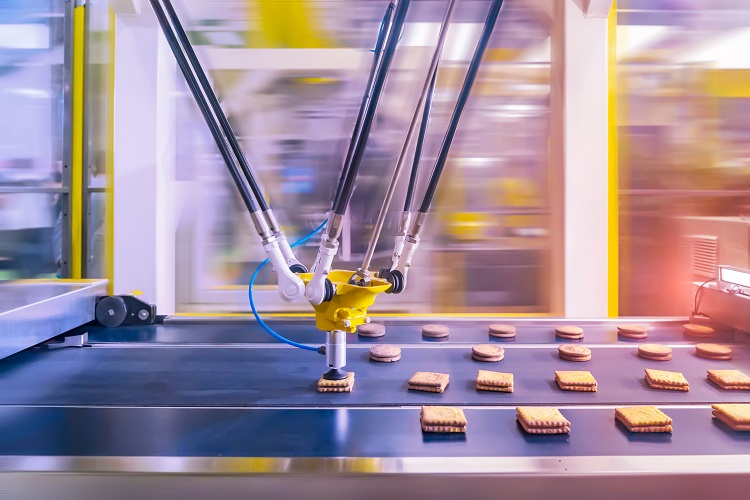Interview with Staubli: Challenges Facing Food Processing Industries

The second part in a three-part series with Staubli Robotics on how robotics is affecting the food processing industry.
Acuity: Food processing has its own challenges, like not every chicken that is cut up is built the same way. How can robots adapt to the differences of the incoming food items?
Stäubli: You are highlighting a crucial part of robotic integration in food production lines, which we call the infeed of a robotic cell. The infeed is the way the product is presented to the robot, and in food this tends to be a lot more variable than in other industries. Food products can vary in shape, weight, consistency, temperature, and viscosity. The solutions for the robot to adapt to this challenge are multiple. First, hygienic conveyors with the proper layout are the foundation of most cells. End users need to have or make the necessary adjustments in order to enable the setup of efficiently designed conveying lines. Then, vision systems are a key component of the whole systems. They are the eyes of the robot and such peripherals have made a lot of progress over the past years with 2D vision, 3D vision, thermal cameras, and built-in AI features to improve efficiency on the go. Last, the end-of-arm tools or grippers are another key factor in successful automation. Like vision systems, the latter have made tremendous leaps in recent years with hygienic wash-down grippers that can imitate the human hand in terms of dexterity and flexibility. As a bonus point, temperature control can help handling applications whenever possible, such as flash-frozen products that present a more stable consistency and viscosity.
Acuity: In what areas within food processing can robots be implemented the easiest?
Stäubli: Food producers often ask where they should start using robots. The right approach is to start with the low-hanging fruit in terms of processes within the plant. Pick-and-place applications are the most common and the easiest to justify in terms of ROI. These processes often consume a lot of labor in tight spaces with jobs that are not attractive, low added value, and a source of work-related musculoskeletal disorders (WRMSDs), which can be costly to employers. Pick-and-place is a broad term in robotics that can cover many applications, including thermoformer loading, orienting, transferring, sorting, Multivac machine loading, packing, cartoning, etc. That being said, our primary environment compatible robots are found across all food segments performing complex tasks such as tray loading, bread scoring, curd slicing, cheese derinding, protein portioning, and deboning. In the end, each plant and project is unique, which is why we like to visit our customers' locations to sit down and talk.
Acuity: What do I need to know before I call a robot supplier to get robotics into my food processing operation?
Stäubli: One thing I always tell people is that an underestimated success factor in the implementation of robotic solutions is to talk to people and organizations who are real experts in their field. That is why I truly encourage people to reach out to us initially as we have a dedicated food robotics team with years of experience. We don’t provide the full system (only the arm, controller, and robot software and services) but we have a broad network of partners we have been working with for a long time. We can easily connect an end user with an integrator who has designed and built similar systems in similar environments with success. By connecting the end user with the best qualified partner integrator, we ensure that our robots will be integrating the right way in a successful system. It saves time, money, and headaches. Everybody wins.
Acuity: What should I ask my supplier before signing on the dotted line?
Stäubli: Most people only think of the up-front costs of buying a robot, but there is a lot more to consider as this investment is a crucial piece of equipment that will perform for many years. The purchase price, delivery, and installation costs need to be considered, but under the surface lie other elements, such as warranty terms, training costs, software fees, consumables, maintenance and services rates—all items that are often overlooked but can significantly impact the total cost of ownership. Therefore, I would advise food producers to exchange with the robot manufacturer directly in order to have all the information at hand when the time comes to make a decision. Going back to the initial costs, I have heard many times the story of end users who chose or were recommended an initially cheaper robotic arm that ended up costing more than truly suitable robots due to a lack of knowledge, no pre-sale engineering study, overestimated performance, resistance to the environment, and more. This is the reason we sell direct only; we want to be involved in each project to ensure the success of our equipment and decline projects that are out of our competencies. We choose to build long-lasting satisfaction and relationships with our customers and partners—that is the role of a true application expert company such as ours.
An insurance company that cares about you and insuring the things you wish to be insured.
Get a Quote> Find an Agent>

